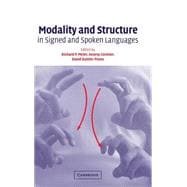
Note: Supplemental materials are not guaranteed with Rental or Used book purchases.
Purchase Benefits
What is included with this book?
|
viii | ||||
|
xi | ||||
|
xiii | ||||
| Acknowledgments | xvii | ||||
|
1 | (26) | |||
|
|||||
| Part I Phonological structure in signed languages | 27 | (140) | |||
|
35 | (30) | |||
|
|||||
|
65 | (23) | |||
|
|||||
|
88 | (24) | |||
|
|||||
|
|||||
|
112 | (31) | |||
|
|||||
|
|||||
|
|||||
|
143 | (24) | |||
|
|||||
|
|||||
| Part II Gesture and iconicity in sign and speech | 167 | (70) | |||
|
175 | (24) | |||
|
|||||
|
199 | (25) | |||
|
|||||
|
|||||
|
224 | (13) | |||
|
|||||
|
|||||
|
|||||
| Part III Syntax in sign: Few or no effects of modality | 237 | (84) | |||
|
241 | (22) | |||
|
|||||
|
263 | (33) | |||
|
|||||
|
296 | (25) | |||
|
|||||
|
|||||
| Part IV Using space and describing space: Pronouns, classifiers, and verb agreement | 321 | (148) | |||
|
329 | (41) | |||
|
|||||
|
370 | (35) | |||
|
|||||
|
|||||
|
405 | (17) | |||
|
|||||
|
422 | (20) | |||
|
|||||
|
|||||
|
|||||
|
|||||
|
442 | (27) | |||
|
|||||
| Index | 469 |
The New copy of this book will include any supplemental materials advertised. Please check the title of the book to determine if it should include any access cards, study guides, lab manuals, CDs, etc.
The Used, Rental and eBook copies of this book are not guaranteed to include any supplemental materials. Typically, only the book itself is included. This is true even if the title states it includes any access cards, study guides, lab manuals, CDs, etc.